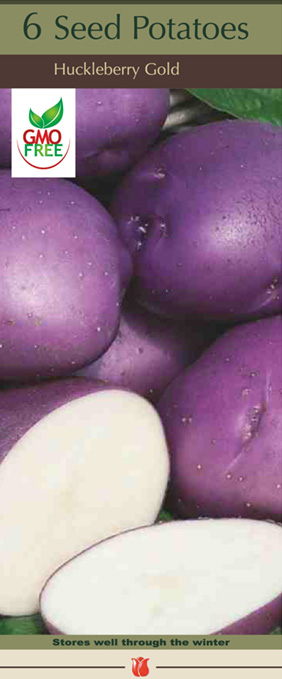Netherland Bulb Company
Known for producing Premium Holland Bulbs 1-800-78-TULIP

Photo © Netherland Bulb Company, Images may not be copied,
altered or reproduced without express written consent.
altered or reproduced without express written consent.
Seed Potatoes
Solanum tuberosum 'Huckleberry Gold'
Have you ever tasted home grown potatoes? Some say there is no comparison to store bought potatoes. Home grown potatoes are fresher, more flavorful and healthier for you. A small number of seed potatoes will yield a few buckets of potatoes ready to eat and enjoy and can even be stored throughout the winter months.
1) Before planting set your seed potatoes in a warm location (between 60 and 70 degrees F.) in full sun such as on a kitchen window sill, for one to two weeks. This will induce sprouting.
2) One day before planting, take a sharp, clean knife and cut the potato into planting pieces. Each piece should be approximately 1 ½ - 2 inch square, and must contain at least 1 or 2 eyes. (Eyes can be identified as the indentations or dimples on a potato) Small potatoes with a minimal amount of eyes may be planted whole.
3) Allow planting pieces to dry and form a callous over their cuts.
Characteristics:
Bloom Time:
Harvest early summer to fall
Mature Height:
In
Hardiness Zone:
4-9 Find your zone
Exposure:
Full Sun
Homeowner Planting and Maintenance Tips:
Potatoes must have well-drained, moisture retentive, fertile soil that is high in organic matter and a pH between 5.0 and 6.0. Do not use a lime soil, the soil should be slightly acid. To prevent disease problems, do not plant potatoes in the same bed as tomatoes. Potatoes should be rotated on a 3 year program. This means, you need 3 suitable sites if you want to grow potatoes every year.
We have done our best to describe this plant as accurately as possible, however, different climates
and growing conditions in different parts of the country will affect height, bloom time, and color.

